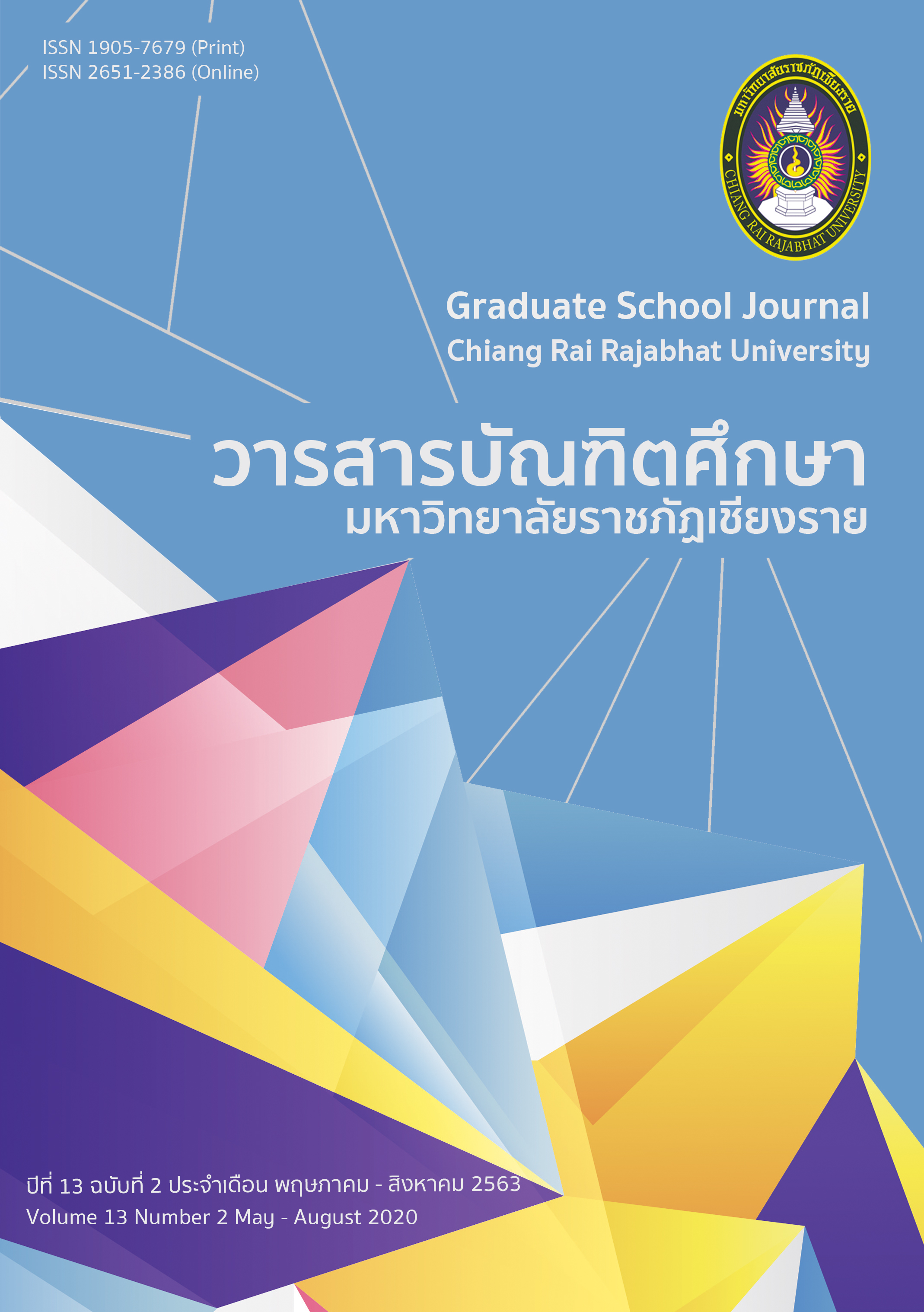การวิเคราะห์ข้อผิดพลาดในการใช้คำบุพบทในงานเขียนภาษาอังกฤษของนักศึกษาชาวจีน
Main Article Content
บทคัดย่อ
การศึกษานี้มีวัตถุประสงค์เพื่อตรวจสอบข้อผิดพลาดในการใช้คำบุพบทในงานเขียนภาษาอังกฤษ และสาเหตุของข้อผิดพลาดในการใช้คำบุพบทในการเขียนภาษาอังกฤษของนักศึกษาชาวจีน กลุ่มตัวอย่างในการวิจัยนี้ คือ นักศึกษาชาวจีนชั้นปีที่ 3 สาขาวิชาภาษาอังกฤษศึกษา มหาวิทยาลัยราชภัฏเชียงราย จำนวน 37 คน ที่คัดเลือกโดยการสุ่มแบบเจาะจง เครื่องมือในการวิจัย ได้แก่ แบบทดสอบการเขียนเรียงความเชิงเล่าเรื่อง แบบทดสอบการเขียนบรรยาย และแบบทดสอบการเขียนแบบโต้แย้ง จากนั้นทำการวิเคราะห์งานเขียนของกลุ่มตัวอย่างโดยจำแนกตามโครงสร้างอนุกรมวิธาน (Surface Structure Taxonomy) ของ Dulay, Burt and Krashen (1982 : 154-162) ได้แก่ การขาดหาย (Omission) การเพิ่มเติมเข้ามา (Addition) การผิดโครงสร้าง (Misformation) และการผิดตำแหน่ง (Misordering) ผลการวิจัยพบว่า
1. มีการใช้คำผิดตามโครงสร้างอนุกรมวิธาน จำนวน 207 คำ ค่าเฉลี่ยของการผิดโครงสร้างคำสูงที่สุด คิดเป็นร้อยละ 49.27 รองลงมา คือ การขาดหาย คิดเป็นร้อยละ 32.37 การเพิ่มเติมเข้ามา
คิดเป็นร้อยละ 17.39 และการผิดตำแหน่ง คิดเป็นร้อยละ 0.96
2. ข้อผิดพลาดของคำบุพบทในการเขียนแบบบรรยายมีจำนวนสูงที่สุด คิดเป็นร้อยละ 35.00 ข้อผิดพลาดของคำบุพบทในการเขียนเชิงเล่าเรื่อง คิดเป็นร้อยละ 34.00 และในการเขียนโต้แย้ง คิดเป็นร้อยละ 31.00 นอกจากนี้ยังมีการเขียนผิดโครงสร้างในการเขียนเล่าเรื่องสูงสุด คิดเป็น ร้อยละ17.39 และ การเขียนผิดตำแหน่งในการเขียนเล่าเรื่องและการเขียนพรรณนา มีค่าต่ำสุดคิดเป็นร้อยละ 0.48
3. สาเหตุของข้อผิดพลาดของคำบุพบทในงานเขียน พบว่า เกิดจากการแทรกแซงของภาษาแม่ ข้อผิดพลาดที่เกิดจากอันตรภาษา และข้อมูลป้อนเข้าของภาษาเป้าหมายที่ไม่เพียงพอ
Article Details
บทความที่ได้รับการตีพิมพ์เป็นลิขสิทธิ์ของวารสารมหาวิทยาลัยราชภัฎเชียงราย
ข้อความที่ปรากฏในบทความแต่ละเรื่องในวารสารวิชาการเล่มนี้เป็นความคิดเห็นส่วนตัวของผู้เขียนแต่ละท่านไม่เกี่ยวข้องกับมหาวิทยาลัยราชภัฎเชียงราย และคณาจารย์ท่านอื่นๆในมหาวิทยาลัยฯ แต่อย่างใด ความรับผิดชอบองค์ประกอบทั้งหมดของบทความแต่ละเรื่องเป็นของผู้เขียนแต่ละท่าน หากมีความผิดพลาดใดๆ ผู้เขียนแต่ละท่านจะรับผิดชอบบทความของตนเองแต่ผู้เดียว
เอกสารอ้างอิง
Alexander, L. G. (1998). Longman English grammar practice for intermediate students. New York: Longman Group.
Brown, H. D. (2000). Principles of language learning and teaching (4th ed.). White Plains, New York: Pearson Education.
Corder, S. P. (1967). The significance of learner’s errors. IRAL: International Review of Applied Linguistics in Language Teaching, 5(4), 161–170.
Corder, S. P. (1985). Error analysis and interlanguage. Oxford: Oxford University Press.
Chen, W. (2002). Acquisition of English passive voice by Chinese learners: A corpus based approach. Foreign Language Teaching and Research, 34(3), 198-202.
Chen, L. (2008). Error analysis in SLA. Journal of Xinxiang Education College, 2, 67-69.
Chai, Y. H. (2009). Error analysis of English prepositions : Corpus-based research on Chinese English learners. Journal of Xi’an Jiaotong University, 5, 12-31.
Durkin, K. (1978). Spatial and temporal prepositions in the language of young school children. Unpublished doctoral dissertation, Cambridge University, England.
Dulay, H., Burt, M. and Krashen, S.D. (1982). Language two. New York: Oxford University Press. Edge, J. (1994). Mistakes and correction. London: Longman.
Ellis, R. (1994). The study of second language acquisition. New York: Oxford University Press.
Ellis, R. (2015). Understanding second language acquisition (2nd ed.). Oxford: Oxford University Press.
Guan, Y. (2013). A corpus-based study on the use of English spatial prepositions of Chinese in, on, at as example. Journal of Liaoning Normal University, 23(4), 215-231.
Gui, S. C. and Yang, H. Z. (2003). The Chinese learner English corpus. Shanghai: Shanghai Foreign Language Education Press.
Huang, Y. H. and Bai, J. H. (2006). Rethinking English prepositional polysemy networks : The case of over. Foreign Language and Their Teaching, 11, 4-7.
Li, J. Y. (2001). The misuses of the English articles in compositions of Chinese college Learners : A corpus-based study. Journal of PLA foreign Languages University, 6, 58-62.
Ma, S. P. (2015). Talking about similarities and differences between Chinese preposition and English preposition. Journal of Hebei University, 34, 4-22.
National Association of Colleges. (2018). Teaching writing in second and foreign language classrooms. Beijiing: Beijing World Publish Corporation.
Odlin, T. (1989). Language transfer. London: Cambridge University Press.
Quan, Y. (2009). Halliday’s view on preposition. Journal of South China University of Technology, 5, 65-70.
Richard, J. A. (1971). Non-contrastive approach to error analysis. English Language Teaching, 25(3), 194-219.
Richards, J. C. (1974). Error analysis : perspectives on second language acquisition. London: Longman.
Richards, J. C. (2001). Curriculum development in language teaching. Cambridge: Cambridge University Press.
Roselind, W. (2009). Sources of errors : An interplay of interlingual influence and intralingual factors. European Journal of Social Sciences, 11(2), 219-250.
Saville-Troike, M. (2006). Introducing second language acquisition. Cambridge : Cambridge University Press.
Shen, L. (2015). An investigation on preposition misusages by college non-English majors. Journal of Dalian Maritime University, 12(4), 5-20.
Spratt, M., Pulverness, A. and Williams, M. (2005). The TKT (Teaching Knowledge Test) course, United Kingdom: Cambridge University Press.
Williams, J. (2004). Teaching writing in second and foreign language classrooms. New York: McGraw Hill.
Xi, J. G. (2013). A typological approach to English & Chinese (E-C) adpositions. Journal of Shanghai International Studies University, 36(3), 44-62.
Xing, Z. Y. (2008). A corpus-based study on the use of preposition on by Chinese college English learners. (Unpublished master’s thesis). Dalian Maritime University. Dalian, China.


